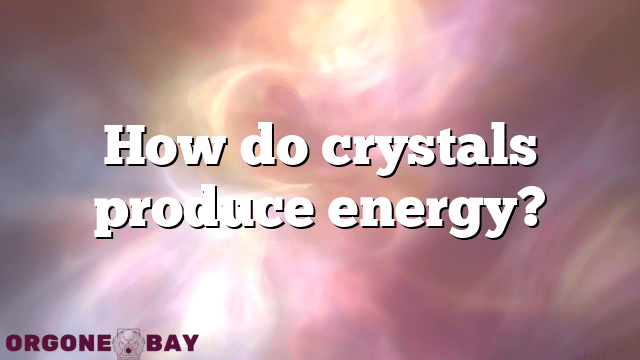Crystal Basics & Properties
How do crystals produce energy?
Crystals have long been revered for their ability to help heal, focus, and promote a sense of well-being. One of the most fascinating properties of crystals is their ability to produce energy, and this can be traced back to a phenomenon called piezoelectricity. This was discovered by French researchers Jacques and Pierre Curie, who found that applying pressure to specific crystals – such as quartz – would produce an electrical charge. Here are some of the ways that crystals produce energy:
– Piezoelectric properties: As mentioned, the piezoelectric effect is a key way that crystals produce energy. When pressure is applied to a crystal such as quartz, the crystal begins to vibrate and generate an electrical charge. This charge can be used to power devices, or to help heal and balance the body’s energy.
– Light and color: Crystals also produce energy through their natural transparency and ability to refract light. When light passes through a crystal, it creates a rainbow-like effect of color and energy, helping to promote healing and balance.
– Mineral content: Different crystals contain different minerals and elements, which can affect their energy production. For example, crystals such as selenite and celestite contain high levels of calcium and can help to promote bone health, while crystals such as amethyst and citrine contain iron and are known for their energizing and uplifting properties.
Overall, the energy produced by crystals is a complex and fascinating topic, and one that has captivated people for centuries. Whether you are interested in using crystals for healing, meditation, or simply for their beauty and energy, there are many ways to tap into the power of these amazing natural wonders.
Table Of Contents
- 1 How Crystals Produce Energy through Piezoelectricity: An In-Depth Look
- 1.1 Understanding Piezoelectricity
- 1.2 The Discovery of Piezoelectricity by Jacques and Pierre Curie
- 1.3 How Mechanical Pressure on Crystals Generates Electricity
- 1.4 Exploring the Piezoelectric Effect in Quartz Crystals
- 1.5 The Role of Crystal Structure in Energy Production
- 1.6 Applications of Piezoelectric Crystals in Modern Technology
How Crystals Produce Energy through Piezoelectricity: An In-Depth Look
Understanding Piezoelectricity
Piezoelectricity is the ability of certain crystals and materials to generate an electrical charge in response to mechanical pressure or vibrations. This phenomenon has been known for over a century and is essential to many modern technologies, from ultrasound machines to quartz watches. Piezoelectricity is one of several ways crystals can produce energy, but it is unique because it converts mechanical energy directly into electrical energy.
The Discovery of Piezoelectricity by Jacques and Pierre Curie
The discovery of piezoelectricity is credited to the French brothers Jacques and Pierre Curie, who were conducting experiments in the late 19th century on crystals and their electrical properties. They noticed that certain crystals, such as quartz, produced an electric charge when subjected to mechanical pressure, such as being squeezed or struck. The Curie brothers named this phenomenon “the piezoelectric effect,” which comes from the Greek word “piezein” meaning to press or squeeze.
How Mechanical Pressure on Crystals Generates Electricity
The piezoelectric effect occurs in crystals that have an asymmetrical structure, meaning they do not have a perfectly symmetrical arrangement of atoms. When a mechanical force is applied to the crystal, it creates a shift in the positions of the atoms, which in turn creates a flow of electrons and generates a small electric charge. Therefore, when piezoelectric crystals are compressed, stressed or vibrated, they produce a measurable output voltage.
Exploring the Piezoelectric Effect in Quartz Crystals
Quartz is one of the most commonly used piezoelectric crystals because of its excellent stability, durability, and availability. The orientation of the quartz crystal determines its piezoelectric properties. The crystal must be cut and polished at precise angles and orientations to generate the desired electrical output. This is why quartz crystals in watches and clocks are cut and shaped to particular dimensions and orientations.
The Role of Crystal Structure in Energy Production
The piezoelectric effect is dependent on the crystal’s structure, symmetry, and constituent elements. Crystals with higher degrees of asymmetry or polarizability, such as quartz, produce stronger piezoelectric effects. Additionally, the size and shape of the crystal, the direction of the force applied, and the purity of the crystal can also affect the magnitude of the electrical charge generated. Therefore, crystallography and crystal engineering play crucial roles in maximizing the piezoelectric efficiency and output of materials.
Applications of Piezoelectric Crystals in Modern Technology
Piezoelectric crystals have a wide range of applications in modern technology, including:
- Ultrasound machines: piezoelectric crystals are used to convert electrical signals into mechanical vibrations and vice versa, which is vital for imaging and diagnosing medical conditions.
- Microphones and speakers: piezoelectric materials can transform sound waves into electrical signals and vice versa. They are used in microphones, speakers and other audio equipment.
- Sensors and transducers: piezoelectric crystals can detect pressure, acceleration, force, and other physical parameters, making them invaluable for sensing and measuring applications.
- Electric lighters: Piezoelectric crystals can generate enough electricity to ignite a spark, which is commonly used in electric lighters.
- Energy harvesting: Some researchers are exploring ways to use piezoelectric materials to generate electricity from ambient vibrations, such as those created by traffic or foot traffic.
In conclusion, piezoelectricity is a fascinating phenomenon that has revolutionized the modern technology industry. The discovery of this principle by Jacques and Pierre Curie has led to countless innovations, and it continues to be an essential area of research and development. As scientists continue to learn more about the properties of crystals and materials, we may see even more applications of piezoelectricity in the future.

